HRM Report: Evaluating HRM Practices at Marks and Spencer (M&S)
VerifiedAdded on 2020/01/23
|31
|9181
|59
Report
AI Summary
This report delves into the realm of Human Resource Management (HRM), contrasting it with traditional personnel management, using Marks and Spencer (M&S) and Aldi as case studies. It highlights the key differences between the two approaches, emphasizing M&S's adoption of HRM for effective resource utilization, employee satisfaction, and organizational productivity. The report then explores the role of line managers in employee engagement, performance appraisals, and disciplinary actions. Furthermore, it examines the impact of legal and regulatory frameworks, such as the Equality Act 2010 and Health and Safety 2016, on HRM practices. The report also analyzes the significance of HR planning, outlining its steps and importance in forecasting future needs. Finally, it compares the selection procedures of M&S and Sainsbury, providing a comprehensive overview of HRM principles and practices.
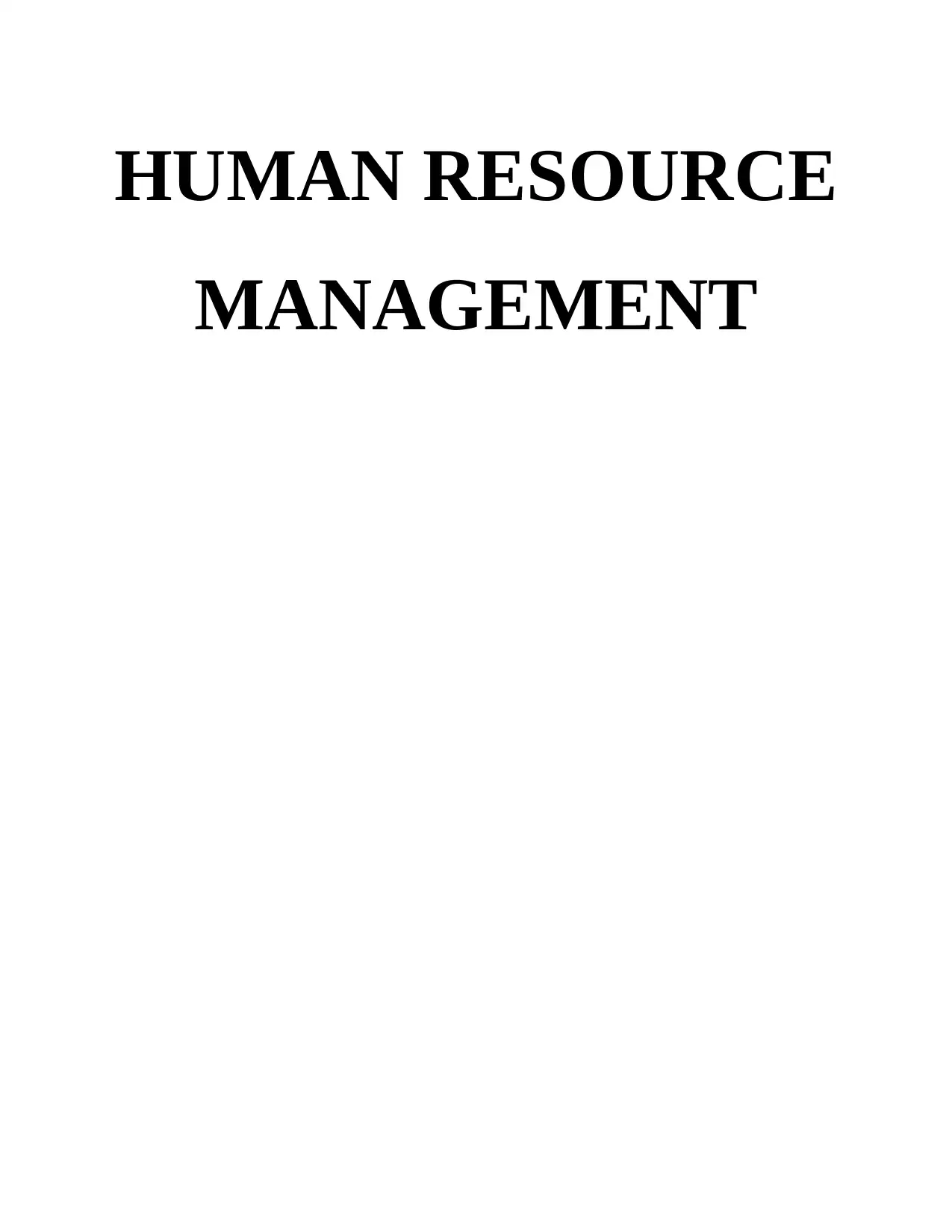
HUMAN RESOURCE
MANAGEMENT
MANAGEMENT
Paraphrase This Document
Need a fresh take? Get an instant paraphrase of this document with our AI Paraphraser
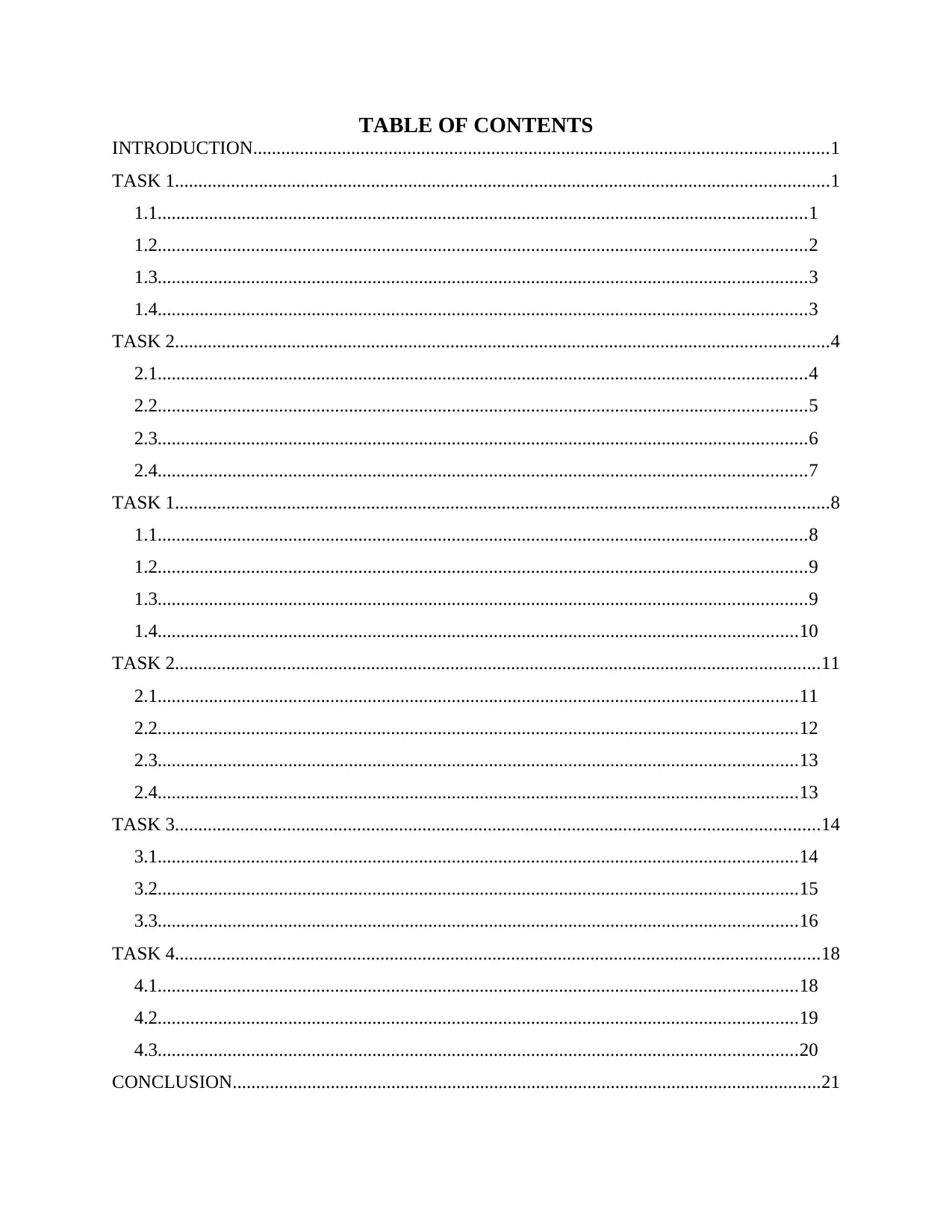
TABLE OF CONTENTS
INTRODUCTION...........................................................................................................................1
TASK 1............................................................................................................................................1
1.1...........................................................................................................................................1
1.2...........................................................................................................................................2
1.3...........................................................................................................................................3
1.4...........................................................................................................................................3
TASK 2............................................................................................................................................4
2.1...........................................................................................................................................4
2.2...........................................................................................................................................5
2.3...........................................................................................................................................6
2.4...........................................................................................................................................7
TASK 1............................................................................................................................................8
1.1...........................................................................................................................................8
1.2...........................................................................................................................................9
1.3...........................................................................................................................................9
1.4.........................................................................................................................................10
TASK 2..........................................................................................................................................11
2.1.........................................................................................................................................11
2.2.........................................................................................................................................12
2.3.........................................................................................................................................13
2.4.........................................................................................................................................13
TASK 3..........................................................................................................................................14
3.1.........................................................................................................................................14
3.2.........................................................................................................................................15
3.3.........................................................................................................................................16
TASK 4..........................................................................................................................................18
4.1.........................................................................................................................................18
4.2.........................................................................................................................................19
4.3.........................................................................................................................................20
CONCLUSION..............................................................................................................................21
INTRODUCTION...........................................................................................................................1
TASK 1............................................................................................................................................1
1.1...........................................................................................................................................1
1.2...........................................................................................................................................2
1.3...........................................................................................................................................3
1.4...........................................................................................................................................3
TASK 2............................................................................................................................................4
2.1...........................................................................................................................................4
2.2...........................................................................................................................................5
2.3...........................................................................................................................................6
2.4...........................................................................................................................................7
TASK 1............................................................................................................................................8
1.1...........................................................................................................................................8
1.2...........................................................................................................................................9
1.3...........................................................................................................................................9
1.4.........................................................................................................................................10
TASK 2..........................................................................................................................................11
2.1.........................................................................................................................................11
2.2.........................................................................................................................................12
2.3.........................................................................................................................................13
2.4.........................................................................................................................................13
TASK 3..........................................................................................................................................14
3.1.........................................................................................................................................14
3.2.........................................................................................................................................15
3.3.........................................................................................................................................16
TASK 4..........................................................................................................................................18
4.1.........................................................................................................................................18
4.2.........................................................................................................................................19
4.3.........................................................................................................................................20
CONCLUSION..............................................................................................................................21
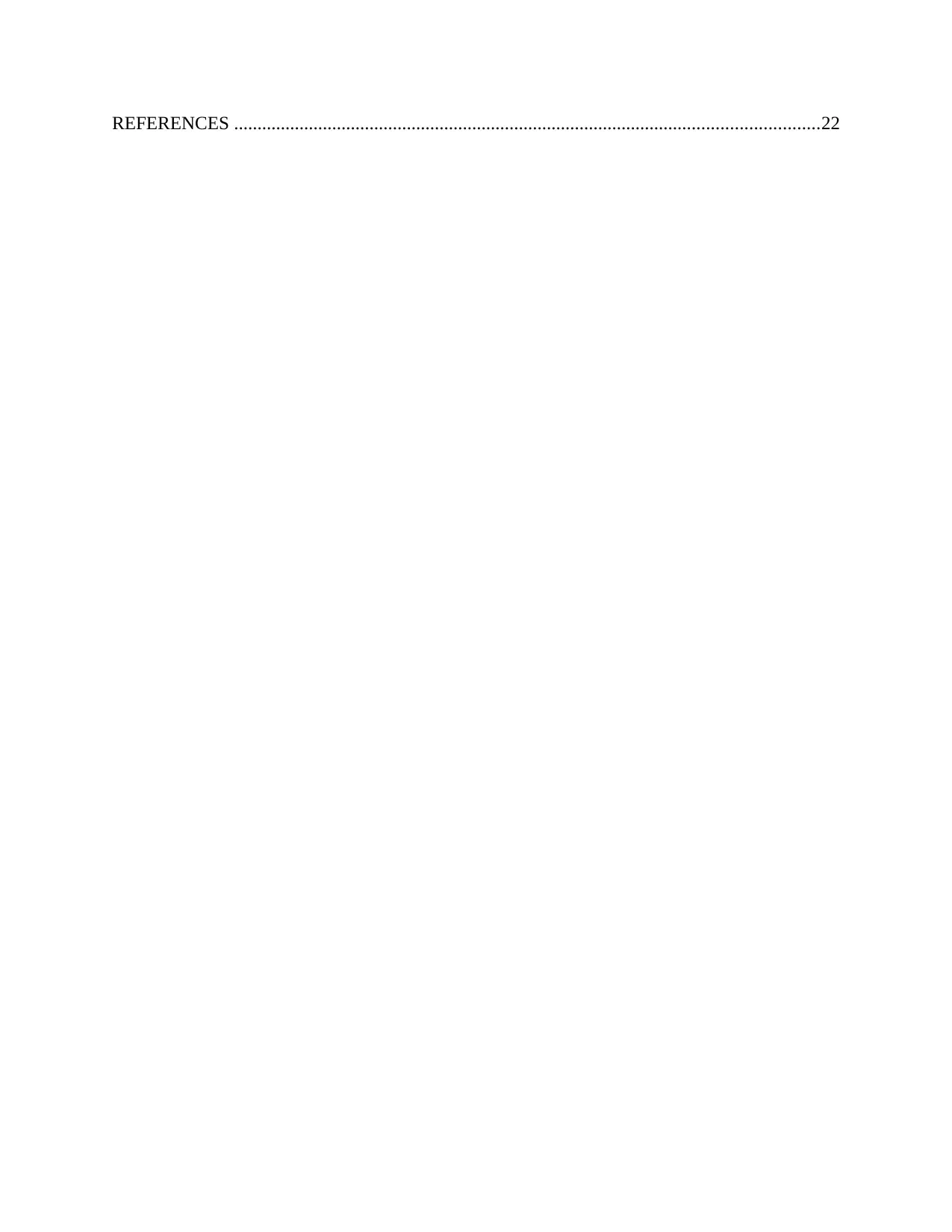
REFERENCES .............................................................................................................................22
⊘ This is a preview!⊘
Do you want full access?
Subscribe today to unlock all pages.

Trusted by 1+ million students worldwide

Paraphrase This Document
Need a fresh take? Get an instant paraphrase of this document with our AI Paraphraser

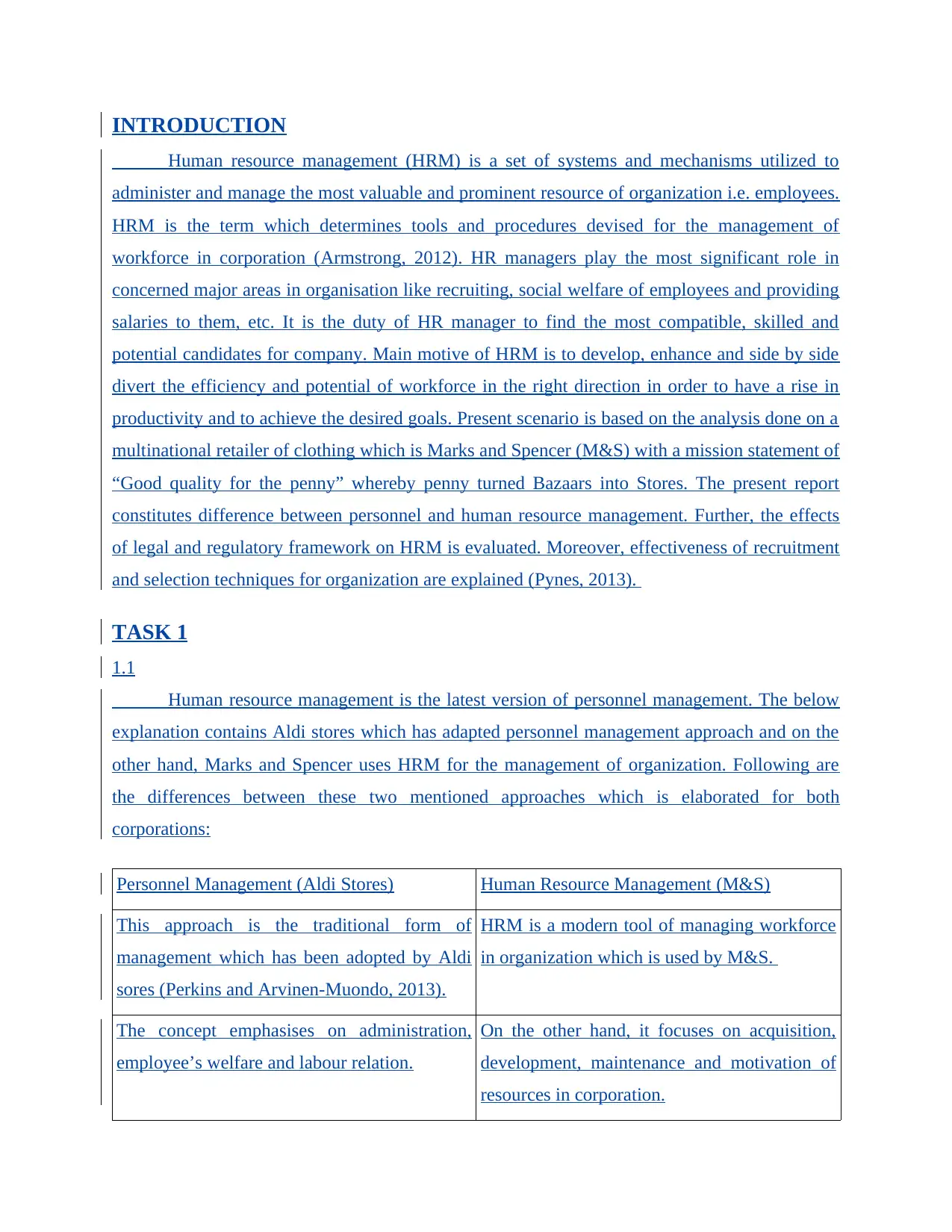
INTRODUCTION
Human resource management (HRM) is a set of systems and mechanisms utilized to
administer and manage the most valuable and prominent resource of organization i.e. employees.
HRM is the term which determines tools and procedures devised for the management of
workforce in corporation (Armstrong, 2012). HR managers play the most significant role in
concerned major areas in organisation like recruiting, social welfare of employees and providing
salaries to them, etc. It is the duty of HR manager to find the most compatible, skilled and
potential candidates for company. Main motive of HRM is to develop, enhance and side by side
divert the efficiency and potential of workforce in the right direction in order to have a rise in
productivity and to achieve the desired goals. Present scenario is based on the analysis done on a
multinational retailer of clothing which is Marks and Spencer (M&S) with a mission statement of
“Good quality for the penny” whereby penny turned Bazaars into Stores. The present report
constitutes difference between personnel and human resource management. Further, the effects
of legal and regulatory framework on HRM is evaluated. Moreover, effectiveness of recruitment
and selection techniques for organization are explained (Pynes, 2013).
TASK 1
1.1
Human resource management is the latest version of personnel management. The below
explanation contains Aldi stores which has adapted personnel management approach and on the
other hand, Marks and Spencer uses HRM for the management of organization. Following are
the differences between these two mentioned approaches which is elaborated for both
corporations:
Personnel Management (Aldi Stores) Human Resource Management (M&S)
This approach is the traditional form of
management which has been adopted by Aldi
sores (Perkins and Arvinen-Muondo, 2013).
HRM is a modern tool of managing workforce
in organization which is used by M&S.
The concept emphasises on administration,
employee’s welfare and labour relation.
On the other hand, it focuses on acquisition,
development, maintenance and motivation of
resources in corporation.
Human resource management (HRM) is a set of systems and mechanisms utilized to
administer and manage the most valuable and prominent resource of organization i.e. employees.
HRM is the term which determines tools and procedures devised for the management of
workforce in corporation (Armstrong, 2012). HR managers play the most significant role in
concerned major areas in organisation like recruiting, social welfare of employees and providing
salaries to them, etc. It is the duty of HR manager to find the most compatible, skilled and
potential candidates for company. Main motive of HRM is to develop, enhance and side by side
divert the efficiency and potential of workforce in the right direction in order to have a rise in
productivity and to achieve the desired goals. Present scenario is based on the analysis done on a
multinational retailer of clothing which is Marks and Spencer (M&S) with a mission statement of
“Good quality for the penny” whereby penny turned Bazaars into Stores. The present report
constitutes difference between personnel and human resource management. Further, the effects
of legal and regulatory framework on HRM is evaluated. Moreover, effectiveness of recruitment
and selection techniques for organization are explained (Pynes, 2013).
TASK 1
1.1
Human resource management is the latest version of personnel management. The below
explanation contains Aldi stores which has adapted personnel management approach and on the
other hand, Marks and Spencer uses HRM for the management of organization. Following are
the differences between these two mentioned approaches which is elaborated for both
corporations:
Personnel Management (Aldi Stores) Human Resource Management (M&S)
This approach is the traditional form of
management which has been adopted by Aldi
sores (Perkins and Arvinen-Muondo, 2013).
HRM is a modern tool of managing workforce
in organization which is used by M&S.
The concept emphasises on administration,
employee’s welfare and labour relation.
On the other hand, it focuses on acquisition,
development, maintenance and motivation of
resources in corporation.
⊘ This is a preview!⊘
Do you want full access?
Subscribe today to unlock all pages.

Trusted by 1+ million students worldwide
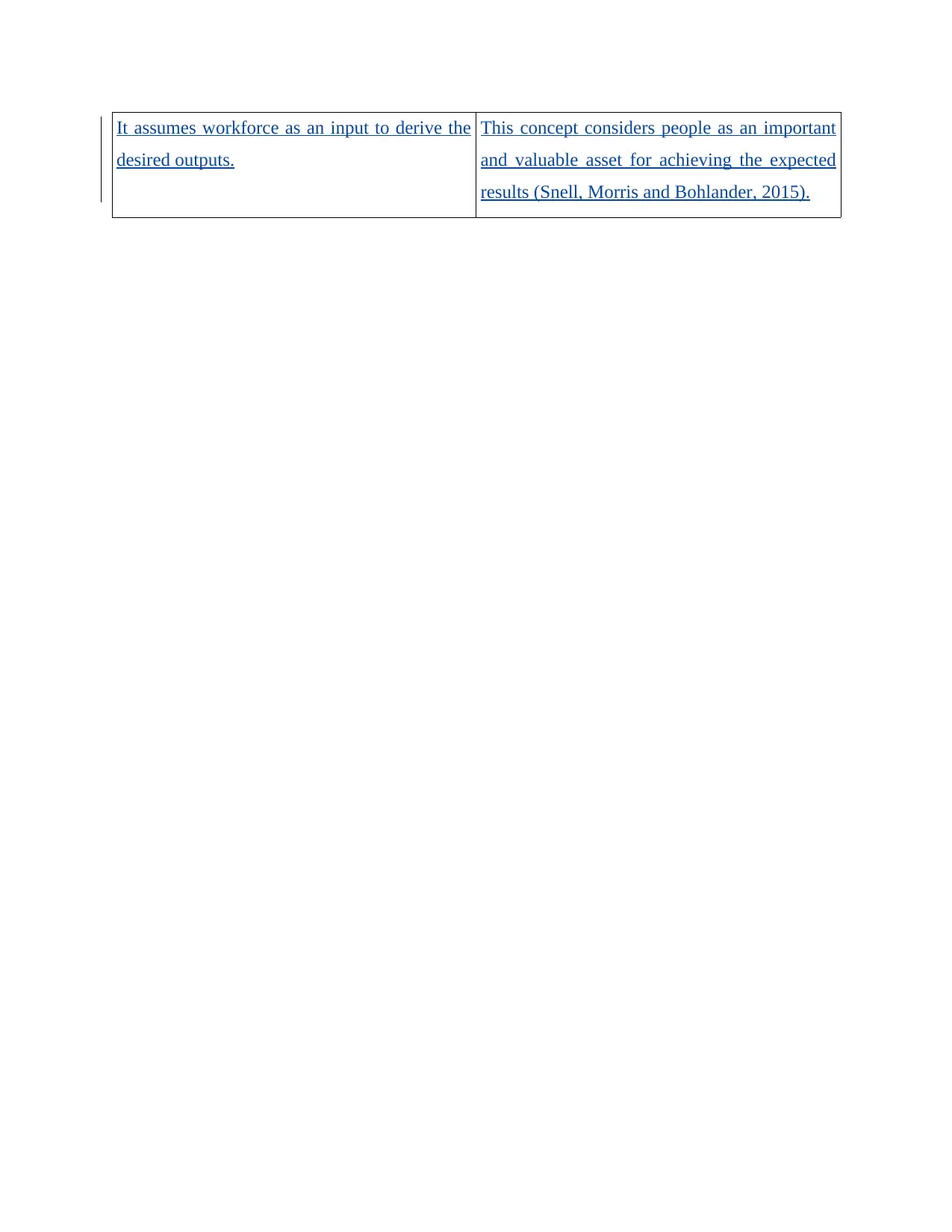
It assumes workforce as an input to derive the
desired outputs.
This concept considers people as an important
and valuable asset for achieving the expected
results (Snell, Morris and Bohlander, 2015).
desired outputs.
This concept considers people as an important
and valuable asset for achieving the expected
results (Snell, Morris and Bohlander, 2015).
Paraphrase This Document
Need a fresh take? Get an instant paraphrase of this document with our AI Paraphraser

Employee’s satisfaction is the priority of this
management system.
This approach undertakes administrative
functions for the achievement if goals.
Training and development sessions are not
provided properly in this system.
More training and development is provided as
compared to the traditional concept.
Personnel management focuses on increased
production and satisfied employees.
HRM focuses on effectiveness, culture,
productivity and employee's participation.
1.2
Main purpose of HRM is to accomplish the organizational goals with keeping employees
highly motivated and satisfied. Therefore, resources are mobilized to achieve such goals. Role of
this management system for M&S is explained as below:
Effective utilization of resources: HRM teaches the way to utilize human and non-human
resources in an organization in the most effectual manner to attain the desired objectives and
goals. As Marks and Spencer is a multinational brand, it has adapted HRM system in order to
effectively utilize the potential of workforce to ensure that specified goals will be achieved on
time. It is essential for the organization to use human resource in an optimum manner ( Snell,
Morris and Bohlander, 2015).
Goal harmony: HRM bridges the gap between individual and organizational goals
thereby resulting in good harmony. If a goal difference occurs, employees will not be willing to
perform well. Hence, a proper balance should be maintained between both kinds of goals in
order to utilize the organizational resources effectively and efficiently.
Employee satisfaction: HRM is a prime factor which is liable for the satisfaction of
workers within organization. This management system in M&S organizes many activities for
employees and takes cares of the welfare of them with creating a favourable environment in
order to ensure that workforce in the organization is satisfied.
Organizational productivity: M&S has adopted HRM which helps the organization in
attainment of higher productivity and ultimate utilization of available resources which leads to
achievement of organizational goals (Azmi, 2009).
management system.
This approach undertakes administrative
functions for the achievement if goals.
Training and development sessions are not
provided properly in this system.
More training and development is provided as
compared to the traditional concept.
Personnel management focuses on increased
production and satisfied employees.
HRM focuses on effectiveness, culture,
productivity and employee's participation.
1.2
Main purpose of HRM is to accomplish the organizational goals with keeping employees
highly motivated and satisfied. Therefore, resources are mobilized to achieve such goals. Role of
this management system for M&S is explained as below:
Effective utilization of resources: HRM teaches the way to utilize human and non-human
resources in an organization in the most effectual manner to attain the desired objectives and
goals. As Marks and Spencer is a multinational brand, it has adapted HRM system in order to
effectively utilize the potential of workforce to ensure that specified goals will be achieved on
time. It is essential for the organization to use human resource in an optimum manner ( Snell,
Morris and Bohlander, 2015).
Goal harmony: HRM bridges the gap between individual and organizational goals
thereby resulting in good harmony. If a goal difference occurs, employees will not be willing to
perform well. Hence, a proper balance should be maintained between both kinds of goals in
order to utilize the organizational resources effectively and efficiently.
Employee satisfaction: HRM is a prime factor which is liable for the satisfaction of
workers within organization. This management system in M&S organizes many activities for
employees and takes cares of the welfare of them with creating a favourable environment in
order to ensure that workforce in the organization is satisfied.
Organizational productivity: M&S has adopted HRM which helps the organization in
attainment of higher productivity and ultimate utilization of available resources which leads to
achievement of organizational goals (Azmi, 2009).
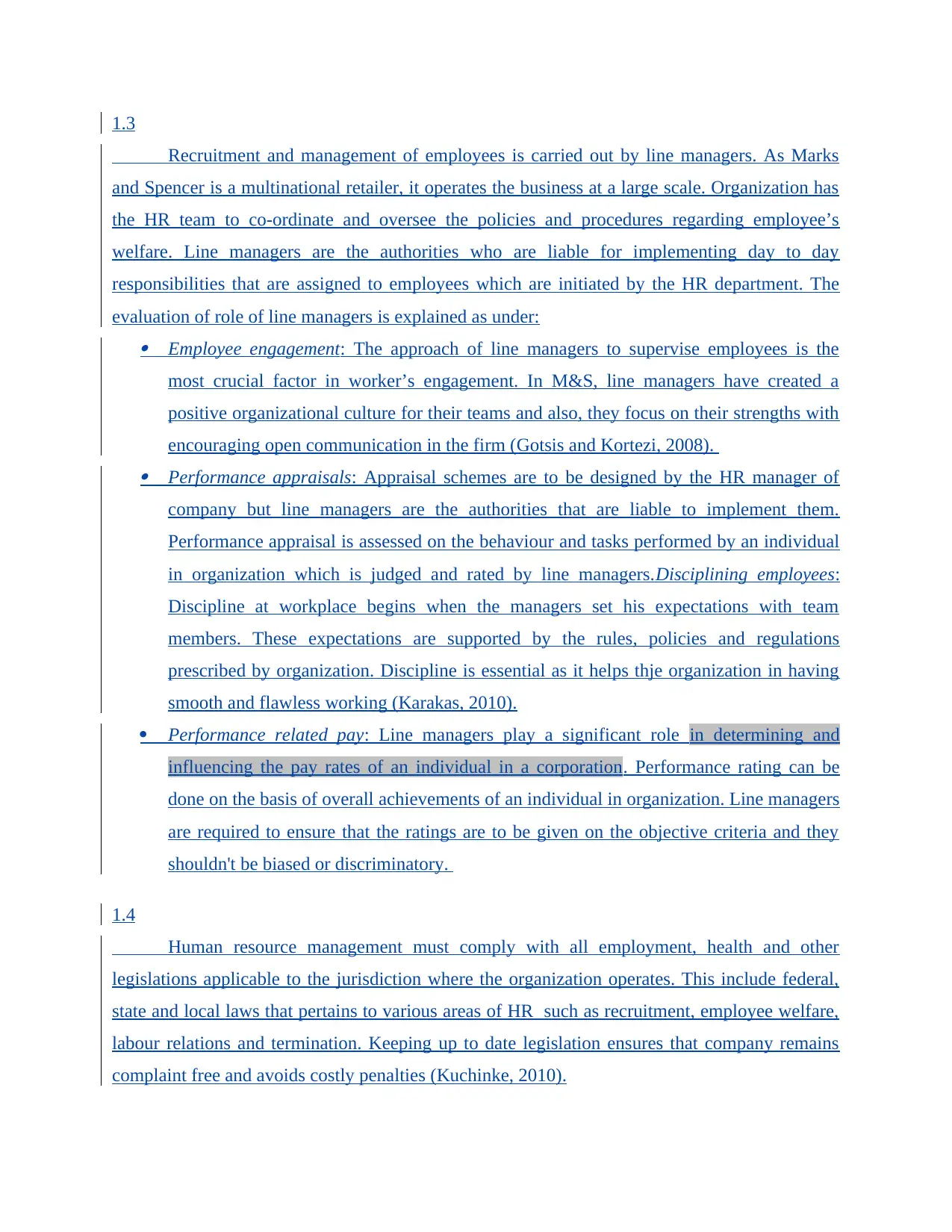
1.3
Recruitment and management of employees is carried out by line managers. As Marks
and Spencer is a multinational retailer, it operates the business at a large scale. Organization has
the HR team to co-ordinate and oversee the policies and procedures regarding employee’s
welfare. Line managers are the authorities who are liable for implementing day to day
responsibilities that are assigned to employees which are initiated by the HR department. The
evaluation of role of line managers is explained as under: Employee engagement: The approach of line managers to supervise employees is the
most crucial factor in worker’s engagement. In M&S, line managers have created a
positive organizational culture for their teams and also, they focus on their strengths with
encouraging open communication in the firm (Gotsis and Kortezi, 2008). Performance appraisals: Appraisal schemes are to be designed by the HR manager of
company but line managers are the authorities that are liable to implement them.
Performance appraisal is assessed on the behaviour and tasks performed by an individual
in organization which is judged and rated by line managers.Disciplining employees:
Discipline at workplace begins when the managers set his expectations with team
members. These expectations are supported by the rules, policies and regulations
prescribed by organization. Discipline is essential as it helps thje organization in having
smooth and flawless working (Karakas, 2010).
Performance related pay: Line managers play a significant role in determining and
influencing the pay rates of an individual in a corporation. Performance rating can be
done on the basis of overall achievements of an individual in organization. Line managers
are required to ensure that the ratings are to be given on the objective criteria and they
shouldn't be biased or discriminatory.
1.4
Human resource management must comply with all employment, health and other
legislations applicable to the jurisdiction where the organization operates. This include federal,
state and local laws that pertains to various areas of HR such as recruitment, employee welfare,
labour relations and termination. Keeping up to date legislation ensures that company remains
complaint free and avoids costly penalties (Kuchinke, 2010).
Recruitment and management of employees is carried out by line managers. As Marks
and Spencer is a multinational retailer, it operates the business at a large scale. Organization has
the HR team to co-ordinate and oversee the policies and procedures regarding employee’s
welfare. Line managers are the authorities who are liable for implementing day to day
responsibilities that are assigned to employees which are initiated by the HR department. The
evaluation of role of line managers is explained as under: Employee engagement: The approach of line managers to supervise employees is the
most crucial factor in worker’s engagement. In M&S, line managers have created a
positive organizational culture for their teams and also, they focus on their strengths with
encouraging open communication in the firm (Gotsis and Kortezi, 2008). Performance appraisals: Appraisal schemes are to be designed by the HR manager of
company but line managers are the authorities that are liable to implement them.
Performance appraisal is assessed on the behaviour and tasks performed by an individual
in organization which is judged and rated by line managers.Disciplining employees:
Discipline at workplace begins when the managers set his expectations with team
members. These expectations are supported by the rules, policies and regulations
prescribed by organization. Discipline is essential as it helps thje organization in having
smooth and flawless working (Karakas, 2010).
Performance related pay: Line managers play a significant role in determining and
influencing the pay rates of an individual in a corporation. Performance rating can be
done on the basis of overall achievements of an individual in organization. Line managers
are required to ensure that the ratings are to be given on the objective criteria and they
shouldn't be biased or discriminatory.
1.4
Human resource management must comply with all employment, health and other
legislations applicable to the jurisdiction where the organization operates. This include federal,
state and local laws that pertains to various areas of HR such as recruitment, employee welfare,
labour relations and termination. Keeping up to date legislation ensures that company remains
complaint free and avoids costly penalties (Kuchinke, 2010).
⊘ This is a preview!⊘
Do you want full access?
Subscribe today to unlock all pages.

Trusted by 1+ million students worldwide
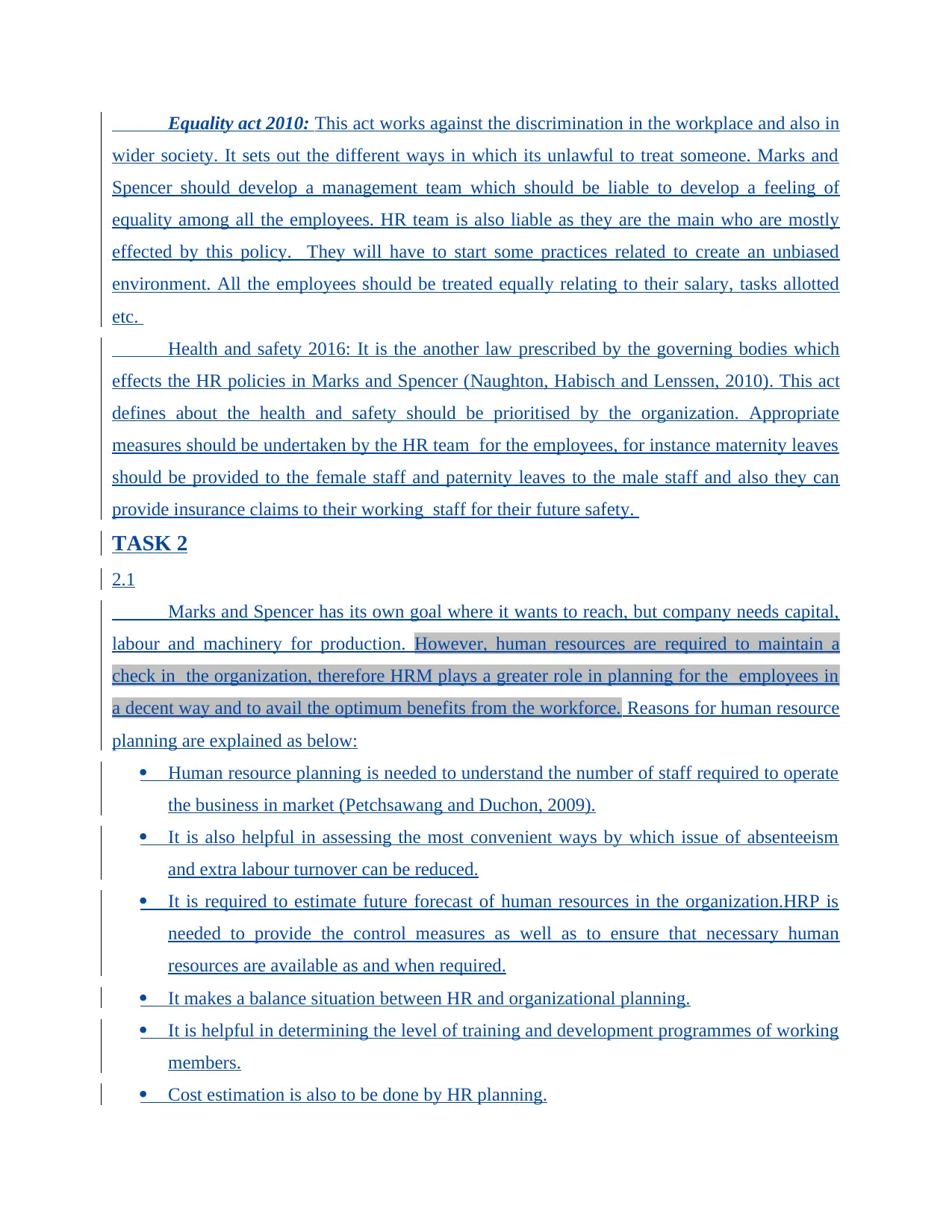
Equality act 2010: This act works against the discrimination in the workplace and also in
wider society. It sets out the different ways in which its unlawful to treat someone. Marks and
Spencer should develop a management team which should be liable to develop a feeling of
equality among all the employees. HR team is also liable as they are the main who are mostly
effected by this policy. They will have to start some practices related to create an unbiased
environment. All the employees should be treated equally relating to their salary, tasks allotted
etc.
Health and safety 2016: It is the another law prescribed by the governing bodies which
effects the HR policies in Marks and Spencer (Naughton, Habisch and Lenssen, 2010). This act
defines about the health and safety should be prioritised by the organization. Appropriate
measures should be undertaken by the HR team for the employees, for instance maternity leaves
should be provided to the female staff and paternity leaves to the male staff and also they can
provide insurance claims to their working staff for their future safety.
TASK 2
2.1
Marks and Spencer has its own goal where it wants to reach, but company needs capital,
labour and machinery for production. However, human resources are required to maintain a
check in the organization, therefore HRM plays a greater role in planning for the employees in
a decent way and to avail the optimum benefits from the workforce. Reasons for human resource
planning are explained as below:
Human resource planning is needed to understand the number of staff required to operate
the business in market (Petchsawang and Duchon, 2009).
It is also helpful in assessing the most convenient ways by which issue of absenteeism
and extra labour turnover can be reduced.
It is required to estimate future forecast of human resources in the organization.HRP is
needed to provide the control measures as well as to ensure that necessary human
resources are available as and when required.
It makes a balance situation between HR and organizational planning.
It is helpful in determining the level of training and development programmes of working
members.
Cost estimation is also to be done by HR planning.
wider society. It sets out the different ways in which its unlawful to treat someone. Marks and
Spencer should develop a management team which should be liable to develop a feeling of
equality among all the employees. HR team is also liable as they are the main who are mostly
effected by this policy. They will have to start some practices related to create an unbiased
environment. All the employees should be treated equally relating to their salary, tasks allotted
etc.
Health and safety 2016: It is the another law prescribed by the governing bodies which
effects the HR policies in Marks and Spencer (Naughton, Habisch and Lenssen, 2010). This act
defines about the health and safety should be prioritised by the organization. Appropriate
measures should be undertaken by the HR team for the employees, for instance maternity leaves
should be provided to the female staff and paternity leaves to the male staff and also they can
provide insurance claims to their working staff for their future safety.
TASK 2
2.1
Marks and Spencer has its own goal where it wants to reach, but company needs capital,
labour and machinery for production. However, human resources are required to maintain a
check in the organization, therefore HRM plays a greater role in planning for the employees in
a decent way and to avail the optimum benefits from the workforce. Reasons for human resource
planning are explained as below:
Human resource planning is needed to understand the number of staff required to operate
the business in market (Petchsawang and Duchon, 2009).
It is also helpful in assessing the most convenient ways by which issue of absenteeism
and extra labour turnover can be reduced.
It is required to estimate future forecast of human resources in the organization.HRP is
needed to provide the control measures as well as to ensure that necessary human
resources are available as and when required.
It makes a balance situation between HR and organizational planning.
It is helpful in determining the level of training and development programmes of working
members.
Cost estimation is also to be done by HR planning.
Paraphrase This Document
Need a fresh take? Get an instant paraphrase of this document with our AI Paraphraser
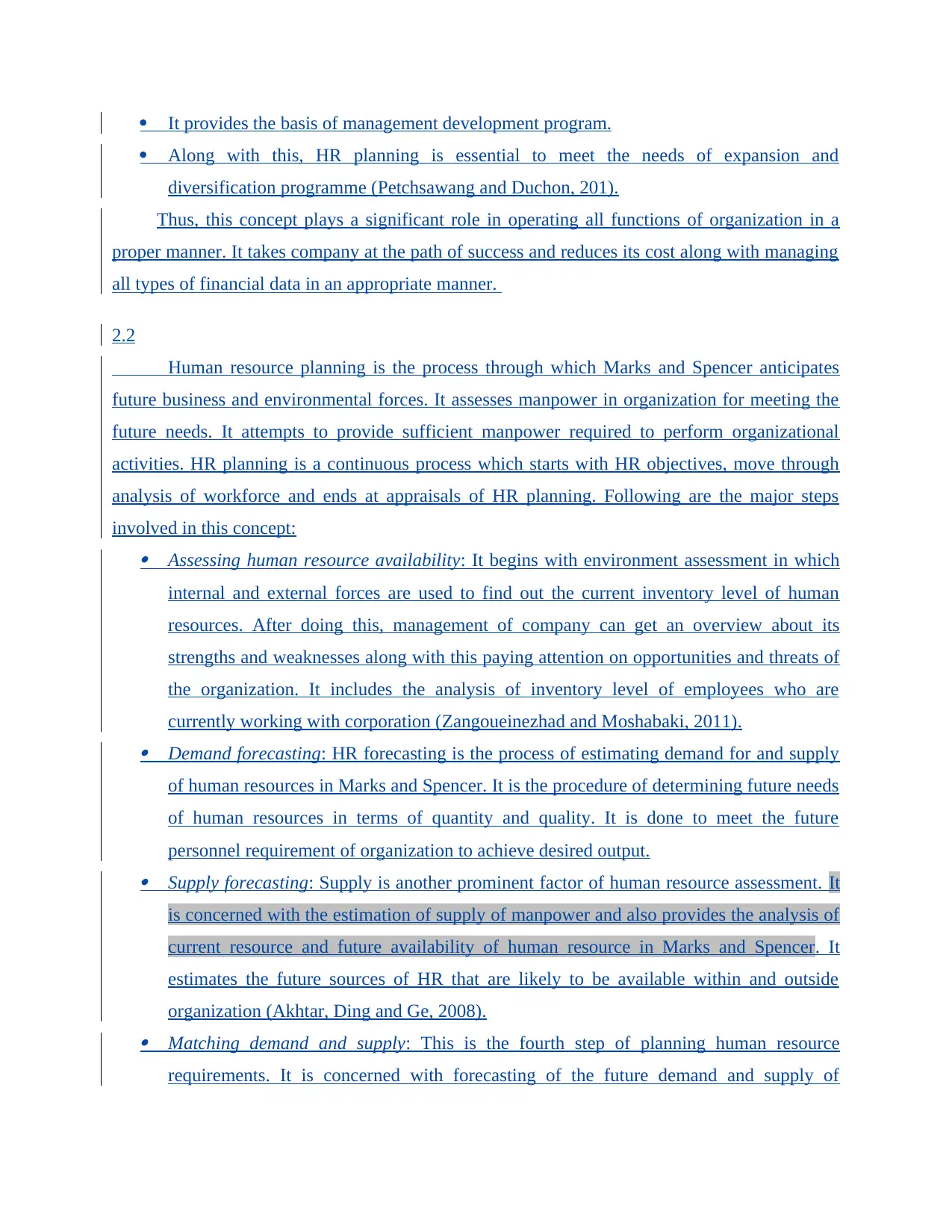
It provides the basis of management development program.
Along with this, HR planning is essential to meet the needs of expansion and
diversification programme (Petchsawang and Duchon, 201).
Thus, this concept plays a significant role in operating all functions of organization in a
proper manner. It takes company at the path of success and reduces its cost along with managing
all types of financial data in an appropriate manner.
2.2
Human resource planning is the process through which Marks and Spencer anticipates
future business and environmental forces. It assesses manpower in organization for meeting the
future needs. It attempts to provide sufficient manpower required to perform organizational
activities. HR planning is a continuous process which starts with HR objectives, move through
analysis of workforce and ends at appraisals of HR planning. Following are the major steps
involved in this concept: Assessing human resource availability: It begins with environment assessment in which
internal and external forces are used to find out the current inventory level of human
resources. After doing this, management of company can get an overview about its
strengths and weaknesses along with this paying attention on opportunities and threats of
the organization. It includes the analysis of inventory level of employees who are
currently working with corporation (Zangoueinezhad and Moshabaki, 2011). Demand forecasting: HR forecasting is the process of estimating demand for and supply
of human resources in Marks and Spencer. It is the procedure of determining future needs
of human resources in terms of quantity and quality. It is done to meet the future
personnel requirement of organization to achieve desired output. Supply forecasting: Supply is another prominent factor of human resource assessment. It
is concerned with the estimation of supply of manpower and also provides the analysis of
current resource and future availability of human resource in Marks and Spencer. It
estimates the future sources of HR that are likely to be available within and outside
organization (Akhtar, Ding and Ge, 2008). Matching demand and supply: This is the fourth step of planning human resource
requirements. It is concerned with forecasting of the future demand and supply of
Along with this, HR planning is essential to meet the needs of expansion and
diversification programme (Petchsawang and Duchon, 201).
Thus, this concept plays a significant role in operating all functions of organization in a
proper manner. It takes company at the path of success and reduces its cost along with managing
all types of financial data in an appropriate manner.
2.2
Human resource planning is the process through which Marks and Spencer anticipates
future business and environmental forces. It assesses manpower in organization for meeting the
future needs. It attempts to provide sufficient manpower required to perform organizational
activities. HR planning is a continuous process which starts with HR objectives, move through
analysis of workforce and ends at appraisals of HR planning. Following are the major steps
involved in this concept: Assessing human resource availability: It begins with environment assessment in which
internal and external forces are used to find out the current inventory level of human
resources. After doing this, management of company can get an overview about its
strengths and weaknesses along with this paying attention on opportunities and threats of
the organization. It includes the analysis of inventory level of employees who are
currently working with corporation (Zangoueinezhad and Moshabaki, 2011). Demand forecasting: HR forecasting is the process of estimating demand for and supply
of human resources in Marks and Spencer. It is the procedure of determining future needs
of human resources in terms of quantity and quality. It is done to meet the future
personnel requirement of organization to achieve desired output. Supply forecasting: Supply is another prominent factor of human resource assessment. It
is concerned with the estimation of supply of manpower and also provides the analysis of
current resource and future availability of human resource in Marks and Spencer. It
estimates the future sources of HR that are likely to be available within and outside
organization (Akhtar, Ding and Ge, 2008). Matching demand and supply: This is the fourth step of planning human resource
requirements. It is concerned with forecasting of the future demand and supply of
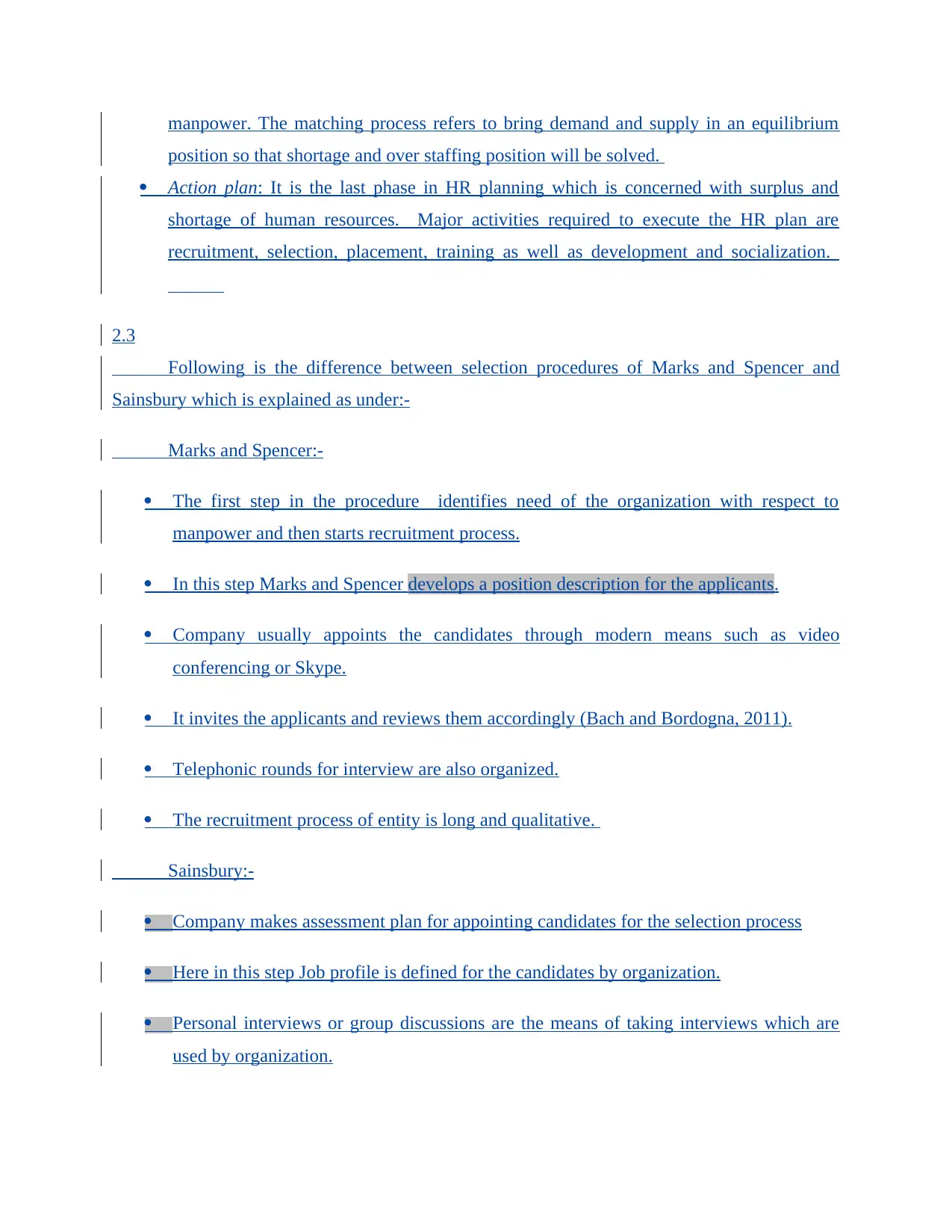
manpower. The matching process refers to bring demand and supply in an equilibrium
position so that shortage and over staffing position will be solved.
Action plan: It is the last phase in HR planning which is concerned with surplus and
shortage of human resources. Major activities required to execute the HR plan are
recruitment, selection, placement, training as well as development and socialization.
2.3
Following is the difference between selection procedures of Marks and Spencer and
Sainsbury which is explained as under:-
Marks and Spencer:-
The first step in the procedure identifies need of the organization with respect to
manpower and then starts recruitment process.
In this step Marks and Spencer develops a position description for the applicants.
Company usually appoints the candidates through modern means such as video
conferencing or Skype.
It invites the applicants and reviews them accordingly (Bach and Bordogna, 2011).
Telephonic rounds for interview are also organized.
The recruitment process of entity is long and qualitative.
Sainsbury:-
Company makes assessment plan for appointing candidates for the selection process
Here in this step Job profile is defined for the candidates by organization.
Personal interviews or group discussions are the means of taking interviews which are
used by organization.
position so that shortage and over staffing position will be solved.
Action plan: It is the last phase in HR planning which is concerned with surplus and
shortage of human resources. Major activities required to execute the HR plan are
recruitment, selection, placement, training as well as development and socialization.
2.3
Following is the difference between selection procedures of Marks and Spencer and
Sainsbury which is explained as under:-
Marks and Spencer:-
The first step in the procedure identifies need of the organization with respect to
manpower and then starts recruitment process.
In this step Marks and Spencer develops a position description for the applicants.
Company usually appoints the candidates through modern means such as video
conferencing or Skype.
It invites the applicants and reviews them accordingly (Bach and Bordogna, 2011).
Telephonic rounds for interview are also organized.
The recruitment process of entity is long and qualitative.
Sainsbury:-
Company makes assessment plan for appointing candidates for the selection process
Here in this step Job profile is defined for the candidates by organization.
Personal interviews or group discussions are the means of taking interviews which are
used by organization.
⊘ This is a preview!⊘
Do you want full access?
Subscribe today to unlock all pages.

Trusted by 1+ million students worldwide
1 out of 31
Related Documents
Your All-in-One AI-Powered Toolkit for Academic Success.
+13062052269
info@desklib.com
Available 24*7 on WhatsApp / Email
![[object Object]](/_next/static/media/star-bottom.7253800d.svg)
Unlock your academic potential
Copyright © 2020–2025 A2Z Services. All Rights Reserved. Developed and managed by ZUCOL.





